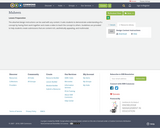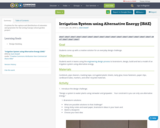
A system for the capture and distribution of rainwater and graywater for the Living Canopy school garden project.
- Material Type:
- Activity/Lab
- Lesson Plan
- Date Added:
- 06/26/2012

A system for the capture and distribution of rainwater and graywater for the Living Canopy school garden project.

Student groups use the Java programming language to implement the algorithms for optical character recognition (OCR) that they developed in the associated lesson. They use different Java classes (provided) to test and refine their algorithms. The ultimate goal is to produce computer code that recognizes a digit on a scoreboard. Through this activity, students experience a very small part of what software engineers go through to create robust OCR methods. This software design lesson/activity set is designed to be part of a Java programming class.

Student teams are challenged to design models of Egyptian funerary barges for the purpose of transporting mummies through the underworld to the afterlife. Planning the boat designs requires an understanding of ancient culture and beliefs so the mummies are transported safely through the perils of the underworld. Students design and build prototypes using materials and tools like the ancient Egyptians had at their disposal. Then they do the same with modern materials and techniques, forming an awareness of the similarities and differences of the barge designs between the ancient materials and tools (technologies) and today's technologies, which are evolved from the earlier ways.
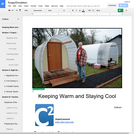
Consistent housing is a continual issue for our community, evidence of this is readily observable in the neighborhoods surrounding our classrooms. Over the course of 15 classroom hours, students will be exploring how they can insulate structures to protect from extreme hot and extreme cold using recycled and/or repurposed materials.
Students will make observations and collect data related to temperature. Student findings will be communicated through science journals, student generated models (charts, 3D structures, drawings, etc.).
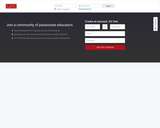
The Literacy Design Collaborative (LDC) provides a curriculum alignment system that helps teachers deliver standards-driven assignments in which students write in response to reading in discipline-specific ways supported by backwards-designed instruction.
LDC tools and learning experiences help teachers and schools meet the challenges of: (1) increasing the rigor of assignments, lessons, and units by becoming truly standards-driven, (2) increasing teachers' knowledge and expertise around instructional planning, and (3) radically changing the expectations schools and teachers have for their students' ability to read and write with depth and breadth—in other words, to be truly college and career ready.
The LDC CoreTools platform includes: (1) a free Curriculum Library that includes nationally-validated tasks and instructional plans that can be modified to meet any teacher's needs; (2) template-driven task and instructional plan editing tools that can be used collaboratively; (3) student-work rubrics and a curriculum-alignment rubric; (4) free professional learning experiences; (5) premium professional learning experiences, resources, and analytics.
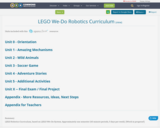
LEGO Robotics Curriculum, based on LEGO We-Do System.
Approximately one semester (45-minute periods, 5 days per week).
[Work in progress!]
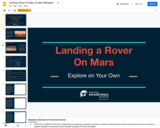
In this Explore on Your Own activity, students will watch a short video about landing spacecraft on Mars and then answer some questions.

This course introduces effective techniques for conducting interviews and is designed to help you develop and strengthen your skills as an interviewer. It does not assume any existing experience conducting interviews, but will quickly take you past the basics and into best practices that incorporate the Lean Research principles of rigor, relevance, respect, and right-size. The course focuses specifically on conducting interviews in “the field”— contexts in which we may be in an unfamiliar setting or culture, such as when traveling abroad or conducting research in a place we haven’t been before.
This course is part of the Open Learning Library, which is free to use. You have the option to sign up and enroll in the course if you want to track your progress, or you can view and use all the materials without enrolling.
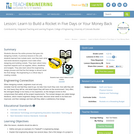
In this lesson, students discover the entire process that goes into designing a rocket for any customer. In prior lessons, students learned how rockets work, but now they learn what real-world decisions engineers have to make when designing and building a rocket. They learn about important factors such as supplies, ethics, deadlines and budgets. Also, students learn about the Engineering process, and recognize that the first design is almost never the final design. Re-Engineering is a critical step in creating a rocket.
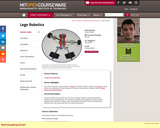
LEGO® robotics uses LEGO®s as a fun tool to explore robotics, mechanical systems, electronics, and programming. This seminar is primarily a lab experience which provides students with resources to design, build, and program functional robots constructed from LEGO®s and a few other parts such as motors and sensors.

This unit engages students in a variety of activities that analyze and reflect on the role of social media in our everyday lives. This includes options for collaborative group work, reading nonfiction articles, a design challenge and presentations to communicate ideas. The unit also includes a formal writing assessment option that aligns with the Common Core State Writing Standards. Activities can be adapted or combined in a variety of ways to support student reflection and analysis. These lessons were piloted in 9th grade English classes but are suitable or a range of secondary students.
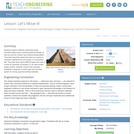
Students explore methods employing simple machines likely used in ancient pyramid building, as well as common modern-day material transportation. They learn about the wheel and axle as a means to transport materials from rock quarry to construction site. They also learn about different types and uses of a lever for purposes of transport. In an open-ended design activity, students choose from everyday materials to engineer a small-scale cart and lever system to convey pyramid-building materials.
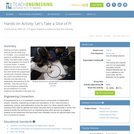
Working as a team, students discover that the value of pi (3.1415926...) is a constant and applies to all different sized circles. The team builds a basic robot and programs it to travel in a circular motion. A marker attached to the robot chassis draws a circle on the ground as the robot travels the programmed circular path. Students measure the circle's circumference and diameter and calculate pi by dividing the circumference by the diameter. They discover the pi and circumference relationship; the circumference of a circle divided by the diameter is the value of pi.
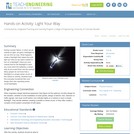
During a power failure, or when we go outside at night, we grab a flashlight so we can find our way. What happens inside a flashlight that makes the bulb light up? Why do we need a switch to turn on a flashlight? Have you ever noticed that for the flashlight to work you must orient the batteries a certain way as you insert them into the casing? Many people do not know that a flashlight is a simple series circuit. In this hands-on activity, students build this everyday household item and design their own operating series circuit flashlights.

This class explores the artistry of Lighting Design. Students gain an overall technical working knowledge of the tools of the trade, and learn how, and where to apply them to a final design. However essential technical expertise is, the class stresses the artistic, conceptual, collaborative side of the craft. The class format is a "hands on" approach, with a good portion of class time spent in a theatre.

Nebraska FCS Classes: Intro to Design

Updated list of free design resources for use by educators. Includes links to photo, illustration, design, and icon resources
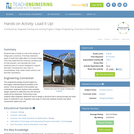
Students take a hands-on look at the design of bridge piers (columns). First they brainstorm types of loads that might affect a Colorado bridge. Then they determine the maximum possible load for that scenario, and calculate the cross-sectional area of a column designed to support that load. Choosing from clay, foam or marshmallows, they create model columns and test their calculations.
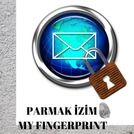
they create original designs from boxes made of materials now, communication tools are made and students make drama with the communication tools they make.
